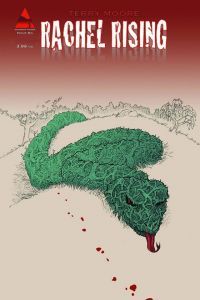"Rachel Rising" #21 by Terry Moore is a transitional issue with two foci, with one scene focused on the fate of Aunt Johnny, and the other following the footsteps of Zoe. The issue isn't filler, though. Both scenes are quick-moving and riveting despite their interstitial nature.
The first third of the issue follows up on Earl, Rachel and Jet as they seek out Dr. Siemen to assist with their plan to save Aunt Johnny even though she is dead. Moore leads in with a cinematic outdoor snow scene on the first page, ending on an image that encapsulates the scene to follow: a bird frozen stiff on the tree branch, preserved in form if not in spirit.
Once indoors, the focus turns to Dr. Siemen, who was a minor character until now. Siemen keeping his dead's wife's remains around in mummified form made him seem creepy and possibly unhinged, but in "Rachel Rising" #21, he is eloquently portrayed as a dignified, learned man, who has kept his wife's remains out of philosophical belief, dogged hope and a search for a way to bring the dead back. His graceful reception of Aunt Johnny's death, then scientific incredulity at Rachel's plan and eventual concession make for a short poetic arc. In particular, Moore's facial expressions are brilliant. They guide Dr. Siemen and the reader swiftly through a gamut of strong emotions: grief and sadness, skepticism, intellectual engagement, resignation, surprise, incredulity and near-anger, shock and then determination. "Rachel Rising" is also gains depth as a story from Moore's return to fleshing out ongoing themes, particularly the duality of the body vs. the soul and the interplay between belief and science.
The next two-thirds of "Rachel Rising" is devoted to an extended catch-up scene with Zoe. After the bloody revelations of the last few issues, in which she has reluctantly fallen in with the Malus-possessed Priest and killed several people, Moore designs a sequence that is all but guaranteed to rekindle reader sympathy for Zoe.
First, Moore makes her relatable in her spot-on facial expressions, especially in a cute "Hulk Smash" moment. Next, Zoe's interaction with the giant dog is irresistible in how it shows that Zoe still has the capacity for compassion. The dog's arrival and the ensuing scuffle are electric-feeling due to Moore's skill with scale and camera angles. Zoe's ability to take care of herself is admirable, and the huge dog is adorable in distress. This part of the story is a classic trick, reminiscent of the story the lion and the mouse, only in this case, the mouse is an experienced killer. Still, the interaction produces a bond that reflects well on both Zoe and the dog.
Finally, Zoe's ruthless disposal of the dog's owner shows that she's a killer again, but the man is a disagreeable, throwaway character, making it easy for the reader to admire Zoe's ability to consistently take down opponents larger and better-armed than herself.
The two scenes with Rachel and Zoe are opposed not only in direction (life vs. death) but also in technique. Both move along quickly, one animated by dialogue and thematic depth, and the other charged with suspense from near-silent action and character development. Moore's breadth of skill and his consistently storytelling makes "Rachel Rising" one of the best long-form stories on the stands.

